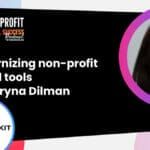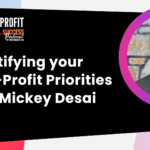Video recording
Audio recording
In today’s episode, we’re happy to have Jane Pfeiffer! She’s the founder & president of Fieldtrip, a non-profit marketing agency. Jane guides the Fieldtrip team to develop sound, strategic work imbued with curiosity and significance.
Jane says her biggest accomplishment is trusting her team to build an agency bigger than anything she could have dreamed of. But we know the truth of it, as she quotes Yoda— ”Do or do not. There is no try.” Jane does.
We brought her on the show to thoroughly discuss the mindset non-profits have when strategizing their marketing efforts.
Mentioned Resources
Episode Transcription
David Pisarek: Welcome to the Non-profit Digital Success Podcast. I’m your host, David, and today I have Jane Pfeiffer on the show. Allow me to introduce her.
Jane is the founder and president of Fieldtrip, which is a brand-new web and advertising agency. She guides the Fieldtrip team to develop sound strategic work with curiosity and significance. She is ferociously dedicated to ensuring everyone in and around the agency knows exactly where they’re headed and how they’re going to get there. Jane, thank you so much for being on the show today. How are you doing?
Jane Pfeiffer: It’s a great day, and I am very excited to be here, David, and be a part of your team and audience and see how we can add value together.
David Pisarek: Fantastic. We were talking before the show about having space and whatnot, and Star Wars is your favorite movie. Do you have any learnings that you bring from the Star Wars franchise into the work that you do?
Jane Pfeiffer: I would say the thing I draw on most often is the Yoda quote about “There is no try, only do”. Our businesses, and I’m sure you’re much the same, are really about space.
At Fieldtrip, our purpose is to close the gap or close the space between the people that are in need, that many non-profits support.
They’ve had trauma, they’re going through tough times in most charitable sectors and then there’s the space between the people that can help them, who have the dollars, who have the time, who have the skills or the connections.
There’s often judgment or a lack of information and education. This Grand Canyon of space between those two create a lot of friction for non-profit leaders and marketers. How do we close that gap? That’s where we’re focused.
Closing that gap is what we call a mission multiplier. There are a couple of things that we address, like “This is what we see, and here are the conditions that you have to address in order to bring those audiences closer together”.
David Pisarek: In terms of closing that gap, there’s the fundamental mindset that non-profit leaders typically have, which is “We’re here to do good”. I think there needs to be maybe a little bit of a shift in terms of the business model for non-profits and how they see themselves and how they operate. Do you believe that the model needs to change?
Jane Pfeiffer: Absolutely. The first pillar and belief that we have is:
We have to think of marketing and shift it forward that is an investment approach and strategy, and not an occasional operational expense that we get to do because we have a one time grant, or because it’s our gala, or because it’s our non-profit special day.
If we were in private business, and we had a product to sell to an audience, we would not open the doors and say “We’re not going to tell anybody we’re here and let’s see how business comes”. Advertising and marketing is a defined and continual light item for businesses.
We have to think about how we think about marketing. And, really, a lot of the problem is not inside the non-profit but in the external world because of traditionally how non-profits have been evaluated based on low overhead, high dollars to the mission. That sounds great on paper, but it isn’t working, or we would’ve solved so many problems already.
The world has to shift and what has to start is with the non-profit marketers and leaders being willing to change their perspective and thinking, and then being ready and informed to have that healthy debate and challenge those outside, or even on their board that “no, this is something we have to show up and invest in, every day”.
David Pisarek: Well, I think there’s a few really great things in there to unpack. Thinking about these non-profits, everybody should be standing on the rooftops yelling about your non-profit, about the amazing work you do, the impact you have.
A lot of the podcast episodes that we’ve had recently, we talk about creating that story and that emotional connection, and really getting people to buy in to the non-profit and understand the mission and how everything is happening, the impact that you have, creating that story around the organization. So I think that’s certainly a key piece there. And in terms of the business model, being in a non-profit doesn’t mean no profit, it’s just a matter of how money is dispersed and how you run your non-profit and the people you have.
If you could be pulling in double your, what I would call revenue, which could be from grants or funding opportunities or government or even private donors, if you can double it, even an extra 50%, how would that impact you? And I think there are some key things there in terms of how effective or ineffective it can be.
Jane Pfeiffer: Yeah. Profit isn’t the biggest reason that the organization is there, but it’s okay that it is a reason because that profit can be reinvested. Just the innovation that can happen if we’re not trying to exhaust the budget every year, and then figure out how we grow utilization of services or how we bring in more sponsorships or get the civic/contracts that we need, or partnerships.
We have to business-fight for market share.
A lot of times marketing is a taboo word, competition is a bad word because most non-profits, again, we work a lot in the health and human services, they’re partnering with other non-profits, or they know that it’s a holistic solution that’s needed, and they’re focusing on one part of that equation. But there is still competition, and that is a good thing because we have to own market share and be known as the solution: “We’re going to be the one that solves hunger in this community”, “We’re going to be the one that helps children prepare for kindergarten”, and we need to be the name that’s associated with that issue and with the solution.
You don’t get there by agreeing to be one of 12, you get there by saying “We’re going to own this”, “We’re not going to try and put others out of business, but we’re going to own it and others will follow and learn from us and that’ll raise everyone up and other organizations will want to collaborate for us, winning is good”.
David Pisarek:
Don’t disparage your competitors, we’re all in this for the best of humanity and community, and all of that wonderful stuff.
But to your point, organizations need to think in terms of their brand and what is their brand, what is their mission, what is their core value, their belief, their guiding star. What is it that is really driving them?
If you stop what you’re doing for a day, and you do an in depth strategic plan and really identify where you want to go and what the mission of your organization is, get buy-in from the leadership obviously, but get buy-in from the people, your volunteers, your donors, the cloud that surrounds your organization, all the people that care about the work that you do, get them to buy into it. Then you can own that thing that you were just talking about so that you can be the world’s best non-profit or charity for whatever that cause is.
Jane Pfeiffer: Yeah. Think about the digital marketers in your audience, if they were regarded as investors, and they were in charge of returning a profit to the organization because they were investing, it would be a different relationship. Now we show up, and it’s like, “How much money do you want? How much is this going to cost me?”. It should be the opposite, “Okay, if we invest here, what’s going to be the rate of return?” and then “Can we grow that by x percentage points over time?” And if we don’t know how to answer, then what are the things that we need to put in place so that we are measuring that.
If we have a hundred percent utilization, imagine the power of that in fundraising to say “Look, there’s more we can do, and we’re doing it so successfully, but we need you”. That’s far different from “Well, we’re fighting for attention on this side for fundraising, but we’re also trying to be known out here so that people even come to us”. Which front do you conquer first? And you’re divided: your attention, your dollar, your message. I mean, what kind of advice or instinct do your clients face when it comes to “Well here comes marketing”.
David Pisarek: Yeah, quite often it’s “Well, we don’t have the time”. A lot of our clients from my agency, it really comes down to time and putting out fires, being reactive instead of proactive, being able to get ahead of the curve and take the time to really stop and think about what it is that would really benefit the organization.
If you’re doing some kind of marketing, figuring out what are those KPIs, how are you going to measure the efficacy of it? How do you know that what you’ve done was fruitful in one way, shape, or form? Not everything is going to have to come down to dollars and cents, there is something to be said for brand awareness and being out there in the community and letting people know who you are. Not everything needs to be about always asking for a donation.
We know money is very tight everywhere, certainly with rates going up and housing and oil costs, putting all that aside a lot of people are struggling and those that want to give really want to give, and they care. How is it that you can connect with them and bring them in? And I’m curious, Jane, from your perspective, what are some of the marketing mistakes that you think are holding back non-profits?
Jane Pfeiffer: I have a list in my head and then that feels a little negative to say “well, this is wrong” but there are so many things that are being done.
One of them is, we’ve already talked about that, treating marketing as an expense and not an investment. Another one is recognizing that there are probably a dozen audiences that a non-profit needs to speak to, and that gets overwhelming. Maybe they’re producing one piece of content and then trying to divide it up against all these different audiences. It makes sense, they’ve going to be efficient with their resources, but I would say in most cases, not all, first start with the audience of your beneficiary, those people that you support, making sure that is as thorough, as clear, as robust as possible so that utilization is there.
You are seen as the one to turn to when X, Y, or Z happens, or a person is in need. If you’re not winning there, then everything else is harder. Focus on that audience first and foremost, and then you can build on it. However, your donors, potential board members, corporate sponsors, when they see an organization that is just absolutely focused on serving and speaking to their beneficiaries, they now have a reason to believe that you’re a solution not because you told them you are, but because they see it in action when they come to your website and the first thing they see is how to find shelter, how to get a meal, how to have a doctor’s appointment, and it’s just front and center: “We’re here to help you take the next step”.
They’re not turned off because it’s not for them, they understand that you’re really thinking about your audience needing something so basic immediately, and you’re making sure it is one click away, that it’s very easy to understand and that strengthens their belief rather than deters them because we’re not talking to donors first and foremost. We should always be demonstrating our maniacal focus on those that we serve.
David Pisarek: A hundred percent, I love that. You need to focus your organization on your audience of who you serve. People are coming to your website that are looking for maybe something related to Parkinson’s disease or care, or there’s thousands and thousands of thousands. But if somebody lands on your website and everything is donor focused, what is it that you’re actually really doing aside from asking for money and collecting it? How is it that you’re creating that impact in the community or helping. Or maybe your non-profit is centered around research and that’s totally cool, but focus on what the research is or who the research helps or what it cures or what it does, or anything like that. Donors are going to go into likely Google and search your non-profit’s name if they hear about you, to find out what it is that you do so that they can look into your organization.
Jane Pfeiffer: Yeah. Another change I would recommend is: you hear the word impact and that’s not a new idea, we talk about the stories that do humanize what we do, but we also need to take that story to the next level. Yes, there’s a heartwarming story about helping a mother and maybe her young child get off the street, get into affordable housing, be able to have well child visits, enrolled in school, a steady job. Those are beautiful things, and that is a tremendous impact in that mother and that family’s life. Let’s also look at the impact of what does that mean in terms of economic impact that now we have another employee who’s showing up, and we’re filling a position. What is the social impact of having a family that is functioning and contributing? Or a child that is getting the education that they deserve on a regular and consistent basis?
Those things, even the most separated mind, or perhaps judgmental, can identify with the importance of having educated children, healthy community, socially stable families and workers that are contributing to our economy. They can more readily connect with that on many situations than “Why is this mother in this situation in the first place?”, “I would never put my child in that”. I hate to sound harsh, but I’ve even been in board of directors meetings where the people who know the mission of the organization have “No, we can’t do that”, “They just shouldn’t be in that situation”. Well, that’s not fair, and it’s not right, and it’s not going to help anyone.
David Pisarek: There’s a mindset shift that needs to happen for anybody that’s involved in an organization that thinks that way, a hundred percent. But further to what you were saying, when you create some kind of impact, when you help somebody, those things that you’re doing as an organization, as an individual, you’re walking down the street, you see somebody about to fall, or is hurt, those things that you do in your life, those changes affects for generations. It’s not a one thing. You’re just going to help this mother and their child or children get proper education or meals or housing, shelter, all that, but how is that to play out down the line? There’s so much that that can happen.
Jane Pfeiffer: Well, it’s that direct impact and then follow the ripple effect.
David Pisarek: A hundred percent. And speaking of ripple effect, talking about marketing, what do people need to do? What is the cadence? What’s the schedule, what’s the frequency, and what is the difference in your mind between consistent and constant marketing?
Jane Pfeiffer: Wow, that’s a great question and I wish that I had the answer because there are several answers. I’d like to know what your answer is. You have to start somewhere, depending on the sector. If the need is there every day, then there’s reason to market every day. But I doubt that there’s a non-profit out there that can go from having $0 in marketing to “Now we’re going to be out there every day”. That’s just not possible. You can pulse it, you can do so many things. I think the most important thing is just to start with one audience, start with one message and build from there and layer on. What advice would you give on that question?
David Pisarek: it’s interesting. We were talking a little bit earlier about knowing the value of your mission and understanding what is the guiding principle. What is your mission as an organization? Really being super clear on that. And then once you’ve got that clear idea, weaving that through all the messaging that you’re doing, being consistent with how you talk about your organization, the people that you help, the way that you do the things that you do, is all about the consistency of it.
Everybody in the organization really needs to buy into that, even if you’re just two people, two volunteers doing something in the rainforest putting together some kind of baskets or something like that, to help out the population down there, or something. The reason, the rationale, the purpose for the work that you’re doing, that really needs to come through everything and then that really builds a compelling story to talk about, and you’ll be able to create that emotional connection, which is going to help drive donations.
But in terms of the cadence in what I would call like constant marketing, you need to be out there on the regular basis pushing out your message, talking about the awesome work you’re doing, or “just got this donation” and “here’s how the money was spent”. People love hearing how their donation helped somebody somewhere or somebody down the line at some point. Again, it’s all about the storytelling. What is it that you can do to really bring your message forward to the masses from that standpoint? In terms of that, not everything should be about asking for money.
You need to be out there telling the stories, talking about the impact you’re having, the great work that was done. Maybe your organization is helping to buy ventilators for hospitals, that’s been the whole big thing the last couple of years, the hospitals are running an event. Maybe that’s what your non-profit or your charity is trying to do. How many people did you help with that? Talk about that a little bit and build what I would call your “hero story”, your brand story around that but in terms of ongoing marketing efforts and that type of thing.
And I was just talking about building that story and talking to donors or prospective donors. About that, what does the donor journey mean to you?
Jane Pfeiffer: A donor’s journey has to be intentional. Donors are changing, non-profits are struggling with how to adopt and adapt to a new generation of donors. What we need to recognize is not the tactic that’s working today, not the message that’s working today, but what type of transformation do we have to offer.
Again, go back to the beneficiaries. How is this organization transforming lives, transforming the world? And then how can you connect that transformation to the fact that you’re making the world the potential donor lives in better?
You have to connect it to them because they no longer want to donate out of guilt or obligation, or just because that makes me a good member of the community. They want to see transformational change, and they want to be changed. Writing that check and then moving on to the next month or the next organization isn’t going to do it. So how can you show and make them feel, more importantly, that they’re better because of it?
As you know, digital’s not going anywhere and there’s so many options and tactics that you can try and things that sound like silver bullets and magic tricks, and most of them are all great, but you can’t rely on a single revolutionary tactic or a single time of the year. It’s got to be part of a really interconnected strategic ongoing plan specially for donors.
David Pisarek: And wouldn’t it be amazing the insight that you can get if you asked all of your donors, why did they donate to you?
Jane Pfeiffer: Yeah, and why not to those who had an opportunity and decided not to? I doubt many people ask that question, and there’s so much to learn.
We tend to sit around the board table and speak to the people who know us the best about what stands in our way when the people who have that answer aren’t in that room, they’re not around that table, they’re out there. So go ask why somebody hasn’t thought of donating to your hunger charity, or school supplies, or whatever that is and see what can be learned from that.
David Pisarek: In terms of the donor journey, you are working with one of your clients and somebody goes to their site, and they donate $50, one time donation for general purpose use or something like that. What do you see as the communication journey that they should go through?
Jane Pfeiffer: I would suggest, obviously, recognizing that, especially if it’s a first time donor, and making that as personal as possible.
It’s easy to set up that auto reply email, but how can that be super specific, super relevant to just give them a good feeling and start that journey of “Hey, I’m making a difference here” and “here’s what that difference looks like” Then at some point in time, obviously you want to continue to communicate, but you have to determine the parameters of when that’s no longer going to generate another result.
There have been organizations because of a memorial or honorarium where I’ve made a gift, and I look at the pieces of mail I am still getting 15 years later. They would’ve been better to never recognize the gift than to continue to have this journey and there’s not been a second gift.
Let’s think about what does that journey look like, and then when do we call it what it is? It was a one time only donation? And we thank them, and now we’re going to fish elsewhere?
David Pisarek: Think to put a lot of time and effort into major gifts or big donors, or corporate partnerships or donations that come in sizeable amounts, putting similar kind of effort and keep going over and over, sending out mailings once or twice a year with a donation. All it is, is donation ask.
My family, we donate to a number of organizations and I don’t hear anything from them until this like piece of mail shows up in my mailbox, like old school snail mail, “Hey, make a donation”, “Here’s what we did over the last year” and it’s like “Talk to me, give me a bit more information”. You can do it electronically where the costs are fractional compared to mailing out. They have my email address, I made all the donations online.
Jane Pfeiffer: Even like, why is it in the charitable world our vernacular is we’re asking for a gift, as opposed to selling a vision? Because then already you’re starting from a defensive position that I have to rationalize and convince somebody to do something they don’t want to do, to give me something that they may think I don’t deserve it, and you’re doing important work.
So just even flipping how you approach that conversation, whether it’s through digital media email or a conversation with a corporate sponsor, you’re selling a vision. That vision had better be bold, and you better be prepared to talk about how you’re on the journey to solve that. Don’t ask, sell it. It’s easier to say than do, but going in, thinking that you’re asking for a gift, you’re carrying in some baggage that you don’t need. It’s tough enough.
David Pisarek: Absolutely. To that point, what would be like the one piece of advice that you would tell people in our audience about?
Jane Pfeiffer:
The one piece of advice is selling the benefit of what you do.
Not the features of the work, but the benefit of the impact and the results.
Really staying in that larger vision, that brand promise, that essence, the mission. Leading with that rather than “we prepare so many meals a day”. We tend to, again, justify rather than sell. So lead with the impact, lead with the mission and lead with that big, bold, brave vision.
David Pisarek: That’s amazing, honestly. If you’re a business, and you’re listening to this, same goes for you, you want to sell your benefit.
Jane Pfeiffer: You’re right. It’s pervasive. We all tend to talk about what we do rather than the benefit of what we do.
David Pisarek: It’s hard to make that mental shift. I love talking with other agency owners who are in this space. There’s so many of us out there, and we’re all here to help organizations, level up and improve, and be able to connect with the people that they want to connect with at a higher level than they have in the past.
And Jane, your passion shines through, this was really great having you on the episode. I’ve got some interesting tidbits here as well that I can take back and chat with my clients. And I really hope the people that are listening to this can take what we’ve spoken about today and actually create some kind of change in their organization as well.
Jane Pfeiffer: I hope so as well. And at any time, David, always willing to have a conversation because the more good we put out there and advice, then that helps everybody change and improve.
David Pisarek: A hundred percent. On that point, if anybody wanted to get in touch with you, do you have any resources? What do they need to do?
Jane Pfeiffer: Yeah, you can visit the website at wearefieldtrip.com/nonprofits, or you can reach me at [email protected]
David Pisarek: That’s awesome. Thanks again so much for joining in, Jane, it’s been great having you on the Non-profit Digital Success podcast.
And to everybody, listen, if you want any of the links or resources that Jane was just talking about, we’re going to link to them on our podcast page. Just head over to nonprofitdigitalsuccess.com, click on this episode for all the details.
Until next time, keep on being successful.














0 Comments